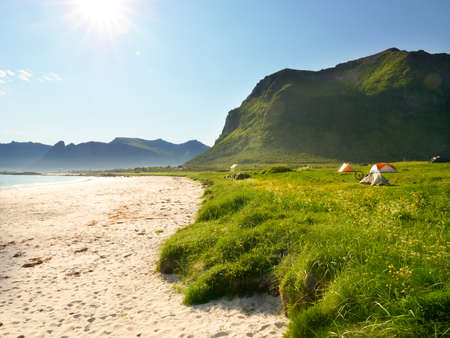Introduction to Hiking and Camping in the Outer Hebrides
The Outer Hebrides, a chain of islands off Scotland’s rugged west coast, are a haven for outdoor enthusiasts seeking raw natural beauty, tranquillity, and a touch of adventure. With dramatic cliffs, windswept beaches, rolling machair grasslands, and ancient peat bogs, this region offers some of the UK’s most striking landscapes for hiking and camping. What truly sets the Outer Hebrides apart isn’t just its scenery—it’s the rich Gaelic culture, warm island hospitality, and deep-rooted traditions that infuse every walk with local character. Whether you’re navigating the wild moors of Lewis or pitching your tent by a white sandy bay on Harris, you’ll find yourself immersed in both nature and community. Practical considerations such as unpredictable weather, limited facilities in remote areas, and access to local amenities are part of the charm—and challenge—of exploring these islands. For those prepared to embrace the elements and respect local customs, the Outer Hebrides promises a uniquely rewarding experience that combines unforgettable hikes with authentic island life.
2. Essential Kit and Local Tips
Before setting off to explore the best hiking and camping routes across the Outer Hebrides, it’s crucial to be properly equipped and aware of the unique challenges posed by this remote Scottish archipelago. With unpredictable weather, rugged terrain, and sensitive environments, preparation is key for both safety and enjoyment.
Must-Have Gear for Hebridean Adventures
| Item | Why You Need It | Local Tip |
|---|---|---|
| Waterproof Jacket & Trousers | The weather can turn quickly, bringing sudden downpours even in summer. | Look for “breathable” fabrics to avoid overheating during climbs. |
| Sturdy Hiking Boots | Boggy paths and rocky outcrops require good ankle support and grip. | Midges are notorious—consider boots that cover ankles to reduce bites. |
| Midge Net & Repellent | Midges swarm from late spring through early autumn. | A head net is a lifesaver at dusk or near standing water. |
| Four-Season Tent | Winds can be fierce; lightweight tents may not withstand gales. | Pitch with entrances away from prevailing winds—usually south-westerly. |
| OS Maps & Compass (or GPS) | Mobile signal is patchy on many islands. | Download offline maps before you leave Stornoway or Barra. |
| Layered Clothing System | Temperatures swing between sun and chill within hours. | Merino base layers dry quickly after sea spray or rain showers. |
| Sufficient Food & Water Supplies | Cafés and shops are rare between villages. | Carry a water filter as streams are plentiful but untreated. |
Wild Camping: Scottish Rights & Responsibilities
The Outer Hebrides offer some of the UK’s best opportunities for wild camping, thanks to Scotland’s progressive access laws. However, respecting local communities and delicate ecosystems is essential:
- The Outdoor Access Code: You have the right to camp on most unenclosed land, but always stay well clear of homes and crofting areas. Pitch late, leave early, and keep groups small (ideally under 3 tents).
- Leave No Trace: Carry out all rubbish—including organic waste like orange peels. Avoid lighting open fires; use a portable stove instead to prevent damage to peatland.
- Loo Etiquette: If you need to go wild, dig a small hole at least 30 metres from watercourses. Pack out used toilet paper in a sealed bag—locals take great pride in their pristine landscapes!
- No Drone Zones: Many popular spots are designated drone-free due to nesting seabirds—check signage before flying for those epic aerial shots.
- Tide Awareness: On causeways and tidal beaches (like Luskentyre), check local tide times to avoid getting stranded or cut off unexpectedly.
- Packing Out: Hebridean weather can change rapidly—always bring extra snacks, dry socks, and an emergency shelter if venturing onto more remote moors or summits.
- Crofting Respect: Sheep roam freely—keep gates closed and dogs under close control at all times.
Your Outer Hebrides Checklist Before Setting Off:
- Packed waterproofs and warm layers?
- Tent checked for strong winds?
- Midge repellent ready?
- Sufficient food and water filtration?
- No-trace plan sorted for all rubbish?
- Offline maps downloaded?
A Final Word:
If you come prepared—with kit for every season in a single day—and show care for the land and its people, you’ll unlock some of Britain’s last truly wild hiking and camping experiences across the stunning Outer Hebrides.

3. Stunning Mainland Treks: Lewis and Harris
If you’re venturing to the Outer Hebrides, the islands of Lewis and Harris offer some of the most unforgettable mainland hiking and camping experiences in Scotland. These landscapes are wild, windswept, and utterly captivating—perfect for those who want their adventures to come with a healthy dose of drama and solitude.
Hebridean Way: The Signature Long-Distance Route
The Hebridean Way is a must for any serious trekker. This epic route stretches over 156 miles (252km), running from Vatersay in the south all the way up to Stornoway on Lewis. The section across Lewis and Harris takes you through moorlands, past lochs, and along ancient peat tracks. Trailheads are well-marked, especially at Tarbert (a popular resupply point) and Stornoway. Expect changeable weather—pack your waterproofs—and prepare for remote wild camping spots where you’ll often have only sheep or seabirds for company.
Eaval Ascent: A Hillwalker’s Dream
For those seeking something shorter but no less rewarding, the Eaval ascent on North Uist offers panoramic views that will make every step worthwhile. While technically not on Lewis or Harris, it’s a favourite side-trip for Outer Hebrides explorers. The trailhead can be found near Loch Euphort; the initial approach can be boggy, so sturdy boots are essential. Once you reach the summit, you’re treated to sweeping vistas of loch-speckled moorland and distant Atlantic waves—a classic Hebridean scene.
Dramatic Coastline Walks of Lewis and Harris
Lewis and Harris are famed for their rugged coasts, with several jaw-dropping walks that hug sea cliffs or snake across sandy machair meadows. Don’t miss the walk from Mangersta to Mealasta, where dramatic cliffs plunge into churning surf below—keep an eye out for sea eagles overhead! Another highlight is the circular route around Luskentyre Beach, renowned for its turquoise waters and white sands that could rival the Caribbean (though you’ll want a good windproof jacket rather than swimwear).
Trailhead Tips & Local Advice
Most trailheads are accessible by local bus services or car, but services can be infrequent—plan ahead if relying on public transport. Wild camping is permitted under Scotland’s access laws, but always follow Leave No Trace principles and respect crofting land. Midges can be fierce in summer, so pack repellent and consider a head net. Finally, bring OS maps or download offline GPS routes as mobile signal can be patchy in remote areas.
4. Island Adventures: Uist, Barra and Beyond
If youre eager to discover the wilder side of the Outer Hebrides, Uist, Barra, and their neighbouring isles offer some of the most untouched hiking and camping experiences in Scotland. Here, far from the crowds, youll find remote beaches kissed by Atlantic winds, sweeping machair meadows bursting with wildflowers, and hidden corners perfect for a peaceful wild camp.
Exploring the Untrodden Paths
Many travellers stick to Lewis and Harris, but venturing further south opens up a world of lesser-known gems. South Uist and North Uist are connected by causeways, making it easy to explore both islands. The rugged beauty of Barra and its outlying islands like Vatersay promise even more solitude for those seeking it.
Top Hiking Routes Across Uist & Barra
| Route Name | Highlights | Approximate Distance | Difficulty |
|---|---|---|---|
| Loch Druidibeag Nature Reserve (South Uist) | Wild lochs, peat bogs, birdlife spotting | 7 miles loop | Moderate |
| North Uist Machair Circuit | Dramatic machair, white sandy beaches, wildflowers in summer | 8 miles circuit | Easy-Moderate |
| The Barra Circular Walk | Clifftop views, Kisimul Castle, secluded coves | 12 miles loop | Moderate-Hard |
| Vatersay Beaches Trail | Twin beaches, turquoise waters, seals and otters sightings | 3 miles return | Easy |
Sensational Wild Camping Spots
One of the joys of hiking in these southern isles is the freedom to wild camp responsibly. Here are my top picks for scenic pitch spots:
- Baleshare Beach (North Uist): A vast stretch of sand with endless sunsets – ideal for an evening BBQ and stargazing.
- Traigh Eais (Barra): Pitched behind the dunes, you’ll fall asleep to the sound of crashing waves – just remember to leave no trace.
- Loch Sgioport (South Uist): Lakeside serenity with mountain views; perfect for early morning swims if you’re feeling brave!
- Vatersay Bay: Sheltered by grassy knolls and only steps from turquoise waters – unbeatable for sunrise coffee.
A Few Local Tips for Your Adventure:
- The weather can change rapidly – pack waterproofs and always check forecasts before setting off.
- Midges can be fierce in summer evenings; a good repellent is worth its weight in gold.
- If youre new to wild camping in Scotland, follow the Scottish Outdoor Access Code: respect privacy, avoid farmland during lambing season, and always take rubbish home.
- Crofting communities welcome respectful visitors; pop into local shops for fresh seafood or homemade cakes.
Uist, Barra and their neighbouring islands truly reward those willing to wander off the beaten path. From serene lochs to deserted beaches fringed with machair blooms, this is the Hebrides at its most authentic – pack your kit, lace up your boots, and enjoy island life as the locals do.
5. Wildlife and Local Encounters
One of the most rewarding aspects of hiking and camping across the Outer Hebrides is the rich tapestry of wildlife and local life you’ll encounter along the way. The islands are a haven for nature lovers, offering some of the UK’s most unique flora and fauna, alongside fascinating glimpses into crofting communities that have shaped these landscapes for generations.
Flora and Fauna: What to Look Out For
The Outer Hebrides are famed for their machair – a rare coastal grassland habitat bursting with wildflowers in late spring and early summer. Keep an eye out for orchids, buttercups, and sea pinks painting the dunes with colour. Birdwatchers will be in their element; you might spot golden eagles soaring overhead, or hear the haunting call of corncrakes hidden in tall grass. Otters frequent the lochs and coastlines, while red deer can sometimes be glimpsed on quieter moorland routes.
Top Spots for Wildlife Watching
For birdlife, the RSPB Balranald Nature Reserve on North Uist is an absolute must – especially during nesting season. The Loch Druidibeg area on South Uist offers a mosaic of habitats teeming with life, from peat bogs to freshwater lochs. If you’re hoping to catch sight of seals or even basking sharks, head for the quieter bays around Berneray or Eriskay. Early mornings and late evenings tend to be best for spotting elusive species.
Respectful Interaction with Crofting Communities
Much of the land you’ll traverse is crofted, meaning it’s actively farmed by local families. Always follow the Scottish Outdoor Access Code: leave gates as you find them, keep dogs under close control (especially around livestock), and avoid disturbing working areas. A friendly wave or quick chat is usually appreciated if you meet crofters along your route—many are happy to share insights into local history or point out hidden gems, provided you approach with courtesy and respect.
Whether you’re quietly observing a distant stag or exchanging a few words at a village shop, these encounters enrich your Outer Hebrides adventure. Tread lightly, stay curious, and let both wildlife and local culture reveal themselves in their own time.
6. Sample Itineraries and Getting Around
Planning your Outer Hebrides adventure can be daunting, but whether you’re after a quick weekend escape or a two-week odyssey, there’s a route to suit every hiker and camper. Here are some practical itineraries tailored for different abilities and timescales, plus essential tips on using ferries, buses, and local connections.
Short Break: Weekend Wanderers
If you’ve just got a couple of days, focus on the Isle of Harris. Start in Tarbert, catch a local bus to Luskentyre Beach for a gentle coastal walk, then camp at Horgabost campsite. On day two, tackle the moderate climb up Ceapabhal for panoramic views before heading back to Tarbert for your return ferry.
Tip:
Book CalMac ferries well in advance during peak season, especially if travelling with a vehicle. Foot passengers and cyclists have more flexibility but should still reserve ahead when possible.
One-Week Adventure: Island Highlights Circuit
Begin in Stornoway (Lewis) and explore the Butt of Lewis Lighthouse trail. Take the bus down to Callanish for the iconic standing stones and wild camping nearby. Continue south via local buses or bike through Harris’s mountain passes, stopping at Seilebost or Hushinish beaches to pitch your tent. Finish your week hiking the Uist trails—catching the ferry from Leverburgh to Berneray—before returning north via public transport links.
Tip:
The Western Isles bus network is surprisingly comprehensive but infrequent—always check timetables with Comhairle nan Eilean Siar (the council) or Traveline Scotland. Buses often connect directly with ferry arrivals/departures.
Epic Two-Week Trek: Full Hebridean Traverse
For seasoned hikers with plenty of time, trek end-to-end from the Butt of Lewis all the way to Barra Head. Follow sections of the Hebridean Way—a waymarked long-distance route linking 10 islands via causeways and ferries. Wild camp en route or book into community-run sites like those at Balranald (North Uist) or Scurrival (Barra). This itinerary covers varied terrain: peat bogs, machair meadows, moorlands and white sand beaches.
Tip:
Ferries between islands fill up fast; plan your crossings strategically and allow buffer days for weather disruptions. Local taxis or hitch-hiking are backup options if you miss a bus—but always let someone know your plans.
Final Transport Pointers
The Outer Hebrides reward those who embrace a slower pace—combine walking with local buses for flexible hop-on/hop-off journeys. Many walkers use baggage transfer services to lighten their load on longer stretches. For real freedom, hire a bike in Stornoway or Benbecula; most inter-island ferries are bike-friendly at no extra cost. With a bit of planning, even first-time visitors can craft an unforgettable Hebridean hiking and camping holiday that flows as smoothly as the island tides.
7. Post-Adventure: Local Eats and Cosy Stays
After a day spent stomping across the rugged beauty of the Outer Hebrides, there’s nothing quite like tucking into some proper Hebridean fare or sinking a pint in a welcoming local. The islands are famed for their hospitality, so whether you’re after a hearty meal or just somewhere to rest your weary legs, you’re spoilt for choice.
Classic Hebridean Dishes to Try
No visit is complete without sampling some fresh seafood—think hand-dived scallops, langoustines, or locally smoked salmon. Many village pubs and inns serve Cullen skink (a creamy smoked haddock soup), while black pudding from Stornoway is a must for breakfast. Don’t pass up the chance to try crowdie cheese or oatcakes, often served alongside a dram of local whisky.
Best Local Pubs and Eateries
The Crown Inn in Stornoway is a favourite with both hikers and locals, offering classic Scottish comfort food and ales. For something cosier, The Anchorage in Leverburgh serves up daily catch specials by the fire. On Barra, Castlebay Bar is legendary for its live music nights and warm welcome—perfect for swapping trail stories with fellow adventurers.
Where to Rest Your Head
If it’s atmosphere you’re after, book into one of the islands’ many B&Bs or characterful bothies. Garenin Blackhouse Village on Lewis offers a unique stay in restored traditional thatched cottages, while Gearrannan Hostel is perfect for those who want budget-friendly warmth with plenty of charm. For wild camping enthusiasts, there are designated spots across the Isles—just remember to follow the Scottish Outdoor Access Code and leave no trace.
Insider Tip
Book ahead in high season; places fill up fast during summer months. And wherever you choose to lay your head or fill your belly, expect a genuine island welcome that’ll make your post-hike wind-down as memorable as the journey itself.


